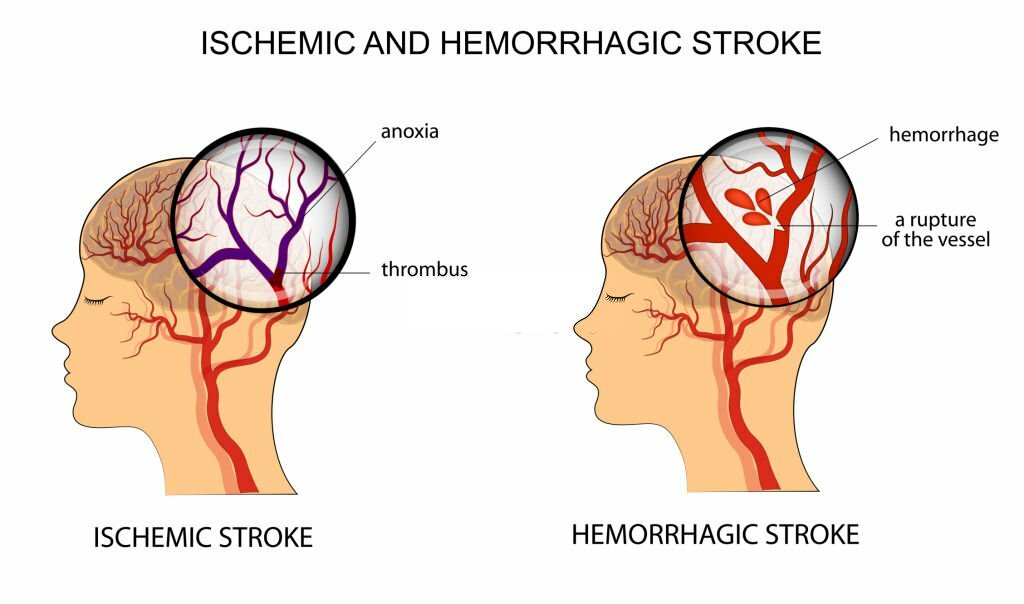Stroke: Symptoms, Causes, Treatment
What are the symptoms of a stroke?
The symptoms of a stroke can vary depending on the type of stroke (ischemic or hemorrhagic) and the area of the brain affected. Common symptoms of a stroke include:
- Sudden numbness or weakness: Weakness or numbness, often on one side of the body, that may affect the face, arm, or leg. This symptom is typically on the same side of the body as the affected area of the brain.
- Confusion or trouble speaking: Difficulty speaking or understanding speech. This may manifest as slurred speech or difficulty finding the right words.
- Trouble with vision: Sudden trouble with vision in one or both eyes, such as blurred or double vision.
- Dizziness or loss of balance: Sudden dizziness, loss of balance, or coordination.
- Severe headache: A sudden, severe headache, especially if it occurs with other symptoms of a stroke.
- Trouble walking: Sudden onset of difficulty walking, such as staggering, loss of balance, or coordination.
It’s important to note that these symptoms can occur suddenly and may vary in severity. If you or someone else experiences any of these symptoms, it’s crucial to seek immediate medical attention. Prompt treatment can help minimize the damage caused by a stroke and improve the chances of recovery.
What are the causes of a stroke?
A stroke occurs when the blood supply to part of the brain is interrupted or reduced, depriving brain tissue of oxygen and nutrients. This can cause brain cells to die, leading to permanent brain damage. There are two main types of stroke, each with different causes:
- Ischemic stroke: This is the most common type of stroke, accounting for about 85% of all strokes. Ischemic strokes occur when a blood clot blocks or narrows an artery that supplies blood to the brain. This can occur in two ways:
- Thrombotic stroke: A thrombotic stroke occurs when a blood clot (thrombus) forms in an artery supplying blood to the brain. This is often due to atherosclerosis, a condition where fatty deposits (plaque) build up in the arteries and restrict blood flow.
- Embolic stroke: An embolic stroke occurs when a blood clot or other debris forms elsewhere in the body (usually the heart) and travels to the brain, blocking a blood vessel.
- Hemorrhagic stroke: Hemorrhagic strokes occur when a blood vessel in the brain ruptures and causes bleeding into the surrounding brain tissue. This can be due to:
- Intracerebral hemorrhage: This type of hemorrhagic stroke occurs when a blood vessel within the brain ruptures and leaks blood into the surrounding brain tissue, causing damage.
- Subarachnoid hemorrhage: This type of hemorrhagic stroke occurs when there is bleeding into the space between the brain and the surrounding membrane (the subarachnoid space), often due to a ruptured aneurysm (a weakened, bulging area of a blood vessel).
Risk factors for stroke include high blood pressure, smoking, diabetes, high cholesterol, obesity, and a sedentary lifestyle. Additionally, factors such as age, family history of stroke, and certain medical conditions (such as atrial fibrillation, a type of irregular heart rhythm) can also increase the risk.
What is the treatment for a stroke?
The treatment for a stroke depends on the type of stroke (ischemic or hemorrhagic) and how quickly treatment is received. Prompt treatment is crucial to minimize brain damage and improve outcomes. Here are the general approaches to treating a stroke:
- Ischemic stroke:
- Clot-busting medication (thrombolytics): If the stroke is caused by a blood clot, a medication called tissue plasminogen activator (tPA) may be given intravenously to dissolve the clot and restore blood flow to the brain. This treatment is most effective when given within 4.5 hours of the onset of symptoms, but it can be used in some cases up to 9 hours after symptom onset.
- Mechanical thrombectomy: In some cases, a procedure called mechanical thrombectomy may be performed to remove the clot using a catheter-based approach. This procedure is typically done for large artery occlusions and can be effective up to 24 hours after symptom onset in certain patients.
- Hemorrhagic stroke:
- Surgery: If the hemorrhage is due to a ruptured aneurysm or arteriovenous malformation (AVM), surgery may be needed to repair the blood vessel and prevent further bleeding.
- Medication: In some cases, medication may be given to control bleeding and reduce the risk of complications.
- Supportive care:
- Monitoring: Patients with stroke may need to be monitored in a specialized stroke unit to closely manage their condition and prevent complications.
- Rehabilitation: After the acute phase of treatment, rehabilitation may be necessary to help patients regain lost abilities and relearn skills. This may include physical therapy, occupational therapy, and speech therapy.
- Medications:
- Blood thinners: If the stroke was caused by a blood clot, blood thinners (anticoagulants) may be prescribed to reduce the risk of future clots.
- Cholesterol-lowering medications: To reduce the risk of future strokes, medications to lower cholesterol levels may be prescribed.
- Blood pressure medications: Controlling blood pressure is important to reduce the risk of another stroke.
- Lifestyle changes: Adopting a healthy lifestyle, including regular exercise, a balanced diet, and avoiding smoking and excessive alcohol consumption, can help reduce the risk of future strokes.
It’s important for stroke patients to receive treatment in a specialized stroke center where a multidisciplinary team of healthcare professionals can provide comprehensive care. Prompt recognition of stroke symptoms and seeking immediate medical attention can greatly improve outcomes.




